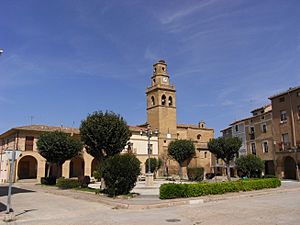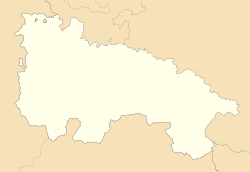Anguciana facts for kids
Quick facts for kids
Anguciana
|
|
|---|---|
 |
|
| Country | |
| Autonomous community | |
| Comarca | Haro |
| Area | |
| • Total | 5.05 km2 (1.95 sq mi) |
| Population | |
| • Total | 434 |
| • Density | 85.94/km2 (222.6/sq mi) |
| Time zone | UTC+1 (CET) |
| • Summer (DST) | UTC+2 (CEST) |
| Postal code |
26210
|
Anguciana is a small village in La Rioja, Spain. It is located in the northwest part of the region. This village is part of the area managed by the town of Haro. Anguciana covers an area of about 5 square kilometers. In 2011, around 471 people lived there.
Contents
History
Anguciana has a long history, dating back many centuries. The first mention of the village was in 1121. A noblewoman named Toda López de Haro y Álvarez gave some of her land in Anguciana to a monastery. Her brother, Diego López de Haro I, also approved this gift. This happened during the time of King Alfonso I of Aragon. He was also known as "the Battler."
Later, starting in the 1300s, the Salcedo family became important in Anguciana. They owned a strong tower near the Tirón River. In 1394, King Henry III of Castile gave the Salcedo family control over Anguciana. This was a reward for their loyalty and service to his father, King Juan I.
In 1397, King Henry III gave them special permission. They could build a very strong house in Anguciana. This house was meant to be as strong as a castle the king would build for himself. This shows how important the Salcedo family and their tower were.
For a long time, Anguciana was part of the Santo Domingo de la Calzada area. This was in the province of Burgos. But in 1833, a new province called Logroño was created. Anguciana then became part of this new province.
Demography
The population of Anguciana has changed over time. In the 1500s, a census counted about 305 people living there. A census is an official count of the population.
In the 1800s, another census in 1840 showed 474 people. Anguciana has seen some interesting population changes. Between 2004 and 2006, the number of people living there grew a lot. It increased by 34%, which was 112 new inhabitants.
By January 1, 2010, the village had 510 residents. There were 281 men and 229 women.
| Vertical bar chart demographic of Anguciana between 1857 and 2010 |
|
EasyTimeline 1.90
|
|
Legal population (1857–1897) according to the population census published by the Instituto Nacional de Estadística in the 19th century. Legal population (1900–1991) or Resident population (2001) according to the population census published by the Instituto Nacional de Estadística. Population according to the municipal register of 2010 published by the Instituto Nacional de Estadística. |
Places of interest
Anguciana has several interesting old buildings to visit.
Buildings and monuments
- Torre Fuerte (Strong Tower)
This tower is a great example of old military buildings. Its construction started in 1397. Juan Alfonso de Salcedo built it near the Tirón River bridge. He got special permission from the king to build this strong fort.
The tower is made of stone and has a rectangular shape. The top has turrets and battlements, which are parts of a castle wall. You can still see some arrow loops, which were openings for archers. The tower has been changed over time. It now has windows and has been divided into different floors inside.
In 1920, a group of Franciscans from Peru bought it. They used it as a school. Later, a private person bought it. The tower is still in good condition today.
- San Martin Church
The building of this church began in the early 1500s. Parts of the church, like some chapels and the tower's base, were built in the 1600s. Other parts were added in the 1700s and 1800s. The very top of the tower was finished in the 1900s.
- Bridge above the Tirón river
There is an old stone bridge over the Tirón River. It offers nice views of the river.
- Santa María de Oreca Hermitage
This small chapel, called a hermitage, dates back to the 1700s.
- Concepción and also the Esclavitud Hermitage
This hermitage is next to the cemetery. It was built in the 1700s. It has one main room and a rectangular front part.
Celebrations
Anguciana has a few special celebrations each year.
- April 29: This day celebrates San Pedro de Verona, a martyr. People have a procession to the Purísima Concepción Hermitage. They carry a statue of the Virgen de la Concepción. It's a tradition to share zurracapote (a local drink) and cheese.
- August 24: This day celebrates San Bartolomé. It is also a day for thanksgiving.
Notable people
Some important people have connections to Anguciana:
- Manuel Pablo Salcedo y Ortes de Velasco: He was a descendant of Juan Alfonso de Salcedo. He was the thirteenth Lord of the castle. He was also part of the Royal House of Castile.
- José Salcedo: He was Manuel Pablo's brother. In the 1700s, he was a senior chaplain in Toledo.
- Julian Cantera Orive: He was a historian from La Rioja. He wrote a book called La Batalla de Clavijo (The Battle of Clavijo). He passed away in 1972.
Images for kids
See also
 In Spanish: Anguciana para niños
In Spanish: Anguciana para niños







